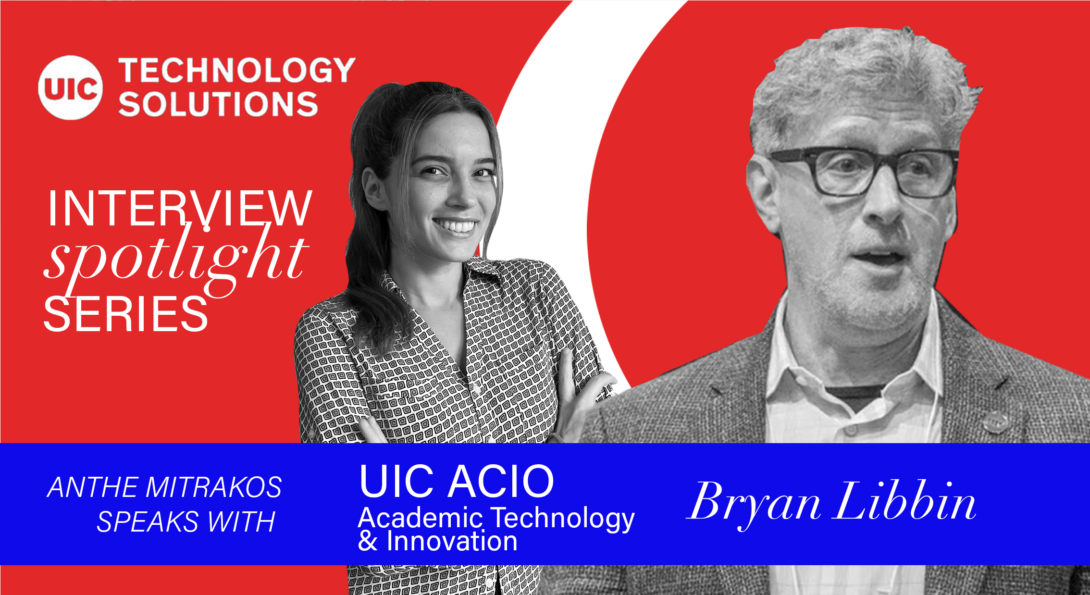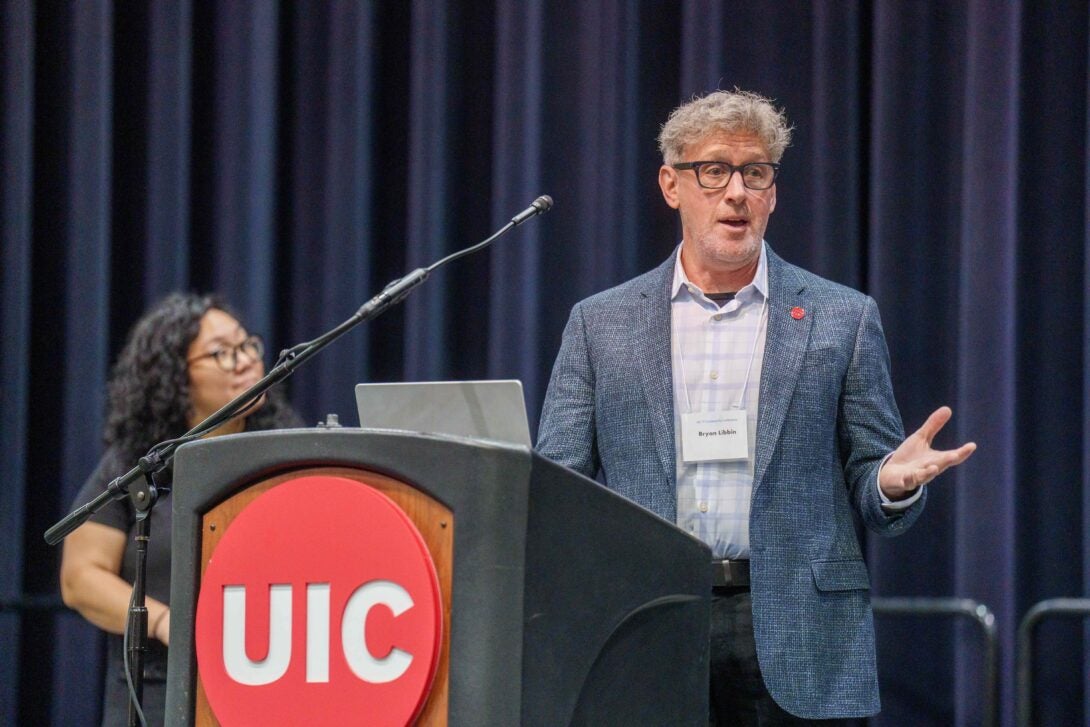The Future of Academic Tech at UIC: An Interview with Associate CIO for Academic Technology & Learning Innovation

Academic technology and learning innovation play a pivotal role in the modern university setting, driving the transformation of education through cutting-edge tools and creative methodologies. These advancements enhance the teaching and learning experience by integrating digital platforms, fostering interactive and personalized learning environments, and facilitating access to vast resources. By leveraging technology, universities can meet diverse learning needs, support faculty development, and promote student engagement and success. Moreover, embracing learning innovation ensures that institutions stay competitive and relevant in an evolving educational landscape, preparing students for the demands of the 21st-century workforce.
In this spotlight interview with UIC Technology Solutions' Marketing & Communications Strategist Anthe Mitrakos, Associate CIO for Academic Technology and Learning Innovation Bryan Libbin discusses his team's work and commitment to furthering UIC’s academic technology ambitions.
Quote 2 Heading link
Our mission is to be a partner for the faculty, staff, and students, fostering the purposeful application and integration of new technologies to enhance teaching, learning, and research. Our team works collaboratively to effectively utilize digital applications and new technologies to address teaching & learning, departmental, and university-wide goals.
| Academic Associate CIO, Learning Technology & Innovation
Spotlight Interview with UIC ACIO for Academic Technology and Learning Innovation: Bryan Libbin Heading link

Anthe Mitrakos:How would you describe a day in the life of an Associate CIO of Academic Technology and Learning Innovation?
Bryan Libbin:
The role of the Associate CIO of Academic Technology and Learning Innovation encompasses an array of responsibilities, each contributing to advancing technological solutions and pedagogical innovation within our academic environment. A typical day in this role is marked by many tasks, which can be categorized into several key domains.
First, resolving issues stands as a primary imperative. This involves the management of emergent challenges within academic technology, necessitating direct engagement with various stakeholders including department chairs, deans, faculty, and staff. Such interactions aim to swiftly address issues impacting their educational endeavors, thereby ensuring seamless technological support and operational continuity.
Team development represents another pivotal facet of the role. Regular meetings with direct reports, both individually and collectively as a leadership team, are instrumental in fostering cohesive teamwork. These engagements serve as platforms for knowledge exchange, feedback solicitation, issue resolution, project updates, and initiating new initiatives. Such collaborative endeavors reinforce the efficacy and synergy of the team, thereby enhancing its overall productivity and effectiveness.
Communication forms an integral component of the role, encompassing the dissemination of information regarding ongoing projects and initiatives. Through diverse channels such as emails, newsletters, meetings, workshops, and discussions, comprehensive outreach is ensured across various stakeholders, including other IT units, colleges, faculty, and students. This robust communication strategy facilitates transparency, fosters collaboration, and engenders a shared sense of purpose among all involved parties.
Project development constitutes a significant focus area, necessitating attention to the conceptualization, execution, and evaluation of academic technology projects. This entails active engagement in tasks such as vendor engagement, contract negotiation, and the assessment of educational applications. By proactively steering project endeavors, I can ensure alignment with TS strategies and optimal utilization of resources.
Last, research and networking are key drivers of innovation and dissemination of best practices. Collaboration with counterparts at other universities facilitates knowledge exchange and benchmarking against industry standards. For instance, initiatives such as the Grammarly pilot engender the sharing of insights with peer institutions. Through such collaborative endeavors, LTS can harness this collective wisdom and drive continuous improvement within the academic technology landscape.
My role embodies a strategic blend of problem-solving, team leadership, communication, project management, and collaborative networking.
Quote 1 Heading link
Collaboration across academic departments, IT teams, and faculty is paramount for successfully implementing technology solutions within higher education. I adopt a multifaceted approach rooted in active listening, service orientation, and creative problem-solving to foster cooperation and cohesive consensus among these diverse stakeholders.
| Associate CIO, Academic Technology & Learning Innovation
Question Heading link
A.M.: Collaboration between academic departments, IT teams, and faculty is crucial in implementing effective technology solutions. How do you approach fostering collaboration and consensus among these diverse stakeholders, especially when faced with differing priorities and perspectives?
B.L.: Collaboration across academic departments, IT teams, and faculty is paramount for successfully implementing technology solutions within higher education. I adopt a multifaceted approach rooted in active listening, service orientation, and creative problem-solving to foster cooperation and cohesive consensus among these diverse stakeholders.
First and foremost, my approach emphasizes the importance of listening attentively to the perspectives and needs of each stakeholder group. While I bring expertise in technology and higher education to the table, recognizing and respecting the unique cultures, processes, and goals of each team, college, and department is essential. Understanding their individual contexts and aspirations can forge stronger partnerships built on mutual understanding and respect.
Furthermore, I uphold a service-oriented ethos within my organization, prioritizing delivering excellent service and support to our stakeholders. This commitment to excellence ensures that their needs remain at the forefront of our endeavors, guiding our actions and decision-making processes. Whether the solution is favorable or poses challenges, our dedication to service excellence ensures that we remain responsive and adaptable to their evolving requirements.
Drawing upon my background in art and design, I approach problems and projects with a creative perspective. I recognize that diverse perspectives often yield the most innovative and effective solutions. Therefore, I encourage my team to embrace their unique viewpoints and leverage their varied skill sets to tackle IT challenges creatively. This diversity of thought within our team enriches our problem-solving processes and enables us to offer fresh insights and alternative approaches to addressing complex issues.
Copy 2 Heading link

A.M.: Academic institutions often face budgetary constraints. How do you prioritize technology investments in alignment with institutional goals and educational priorities?
B.L.: Prioritizing technology investments within academic institutions necessitates a thoughtful and strategic approach, particularly in light of budgetary limitations and the ability to align with institutional goals and educational priorities. To achieve this, I employ a framework that emphasizes the careful balance between various categories of applications and the lifecycle management of academic technologies.
First and foremost, we need to recognize the importance of maintaining equilibrium among different types of applications. This includes delineating between new applications earmarked for piloting and universally supported platforms such as Learning Management Systems (LMS). These fringe applications are financially supported by individual colleges but managed by Learning Technology Services (LTS), and applications are slated for retirement. This categorization ensures that investments are distributed strategically to address the diverse needs of stakeholders while optimizing resource utilization.
Moreover, the university needs to acknowledge that the lifecycle of educational applications is finite, characterized by stages of piloting, adoption, launch, review, and eventual replacement. For instance, our decision not to renew the contract with Class Collaborate last year allowed us to reallocate resources towards adopting Ally, aligning with our institutional commitment to enhancing accessible course content.
In parallel, my team is conducting regular evaluations of the applications within our ecosystem, assessing factors such as usage metrics, cost-effectiveness, support models, and alignment with institutional priorities. This ongoing assessment enables us to make informed decisions regarding the future trajectory of our learning app ecosystem.
Looking ahead, we are committed to thoroughly examining our technology investments over the next 3 months, 6 months, and 1 year. This examination will entail a comprehensive analysis of the depth and breadth of usage, cost considerations, support models, and ultimately, how these investments align with our institutional vision for teaching and learning. By strategically aligning technology investments with institutional goals and educational priorities, we endeavor to create a sustainable technology ecosystem that enriches the educational experience for all stakeholders within our institution.
Copy 3 Heading link

A.M.: The landscape of higher education is rapidly evolving with online learning, adaptive technologies, and data analytics playing increasingly important roles. How do you envision the role of academic technology evolving over the next few years?
B.L.: The role of academic technology must adapt to meet the evolving needs of students, faculty, and staff. A key aspect of this evolution involves meeting students where they are, particularly in the context of our commuter campus where mobility is a prevalent factor in students’ daily routines. Therefore, a crucial focus for LTS is to ensure that content, resources, and support are not only accessible but also mobile-friendly and conducive to distance learning environments. This approach enables us to cater to the diverse needs of our student population and facilitate seamless engagement with educational materials.
Another important aspect I consider when thinking about the future of academic technology revolves around enhancing university-wide engagement. LTS is actively seeking applications that not only support teaching and learning but also foster meaningful engagement among students, faculty, and staff. Zoom is an exemplary model in this regard, offering a versatile platform for content creation, synchronous and asynchronous interactions, event hosting, virtual office hours, and collaborative teamwork. By leveraging such multifaceted tools, we aim to cultivate an environment that promotes active participation and interaction in various educational contexts.
Furthermore, as a formally trained instructional designer, I am committed to expanding and enhancing instructional design practices within our institution. While some colleges may already benefit from dedicated instructional designers, we aim to ensure equitable access to these resources across all schools. To achieve this, I collaborate closely with Cheryl McKearin to promote the growth of instructional design principles and methodologies within our Learning Technology Services (LTS) department. Through targeted communication, workshops, and one-on-one consultations, we aim to empower faculty and staff with the knowledge and skills necessary to leverage instructional design principles effectively in their teaching and learning endeavors.
Copy 3 Heading link

A.M.: Are there any projects/efforts happening in 2024 that you would like to highlight?
B.L.: There are several exciting projects underway that I’m eager to share. First, I’d like to spotlight our ongoing pilot with Grammarly, which holds unique significance for our team. This marks the first pilot that my team and I have launched from inception to execution since I joined UIC. It’s been a collaborative effort to expedite its implementation, and we’re committed to expanding this initiative throughout the year. This university-wide pilot is designed to engage faculty, staff, and students in distinct yet meaningful ways. We’ll continue refining our partnership with Grammarly to better align with our school’s needs, ensuring the platform evolves to meet our requirements. Notably, we’ve recently announced that Grammarly is HIPAA compliant, and any new tools within the Grammarly license will undergo objective evaluation by our IT governance and faculty senate before adoption. Moreover, we’ll actively involve faculty, staff, and students in shaping the future integration of Grammarly within our university.
Furthermore, I’m thrilled to introduce an initiative showcased at ITCC – the opportunity to build one’s own AI model. We’re exploring software solutions that enable students, faculty, and staff to experiment with AI in a secure and user-friendly environment. I plan for LTS to sponsor a contest fostering innovation, creativity, and research this fall. Applicants will have the chance to receive a free AI brain to develop, experiment with, and share their findings with the university community. We’ll evaluate submissions based on specific criteria, presenting awards across various categories. Stay tuned for more details in early fall!
Finally, data within the LMS includes various metrics such as student performance, assignment completion rates, and engagement levels. These metrics can provide invaluable insights into the effectiveness of course design and assessments. Yet, its utility remains underutilized without a clear understanding of interpreting and applying this data. Faculty may need help accessing and interpreting this information, leading to missed opportunities for enhancing course quality and student performance.
Recognizing this challenge, LTS is pioneering the integration of AI to bridge the gap between data and actionable insights. AI tools are being introduced to make data more accessible and comprehensible for faculty. These tools will be initially designed to demystify data analytics and eventually used to provide clear, actionable recommendations. AI can simplify the process by automatically generating insights from complex datasets, highlighting trends, and suggesting areas for improvement. In the future, we would like the tools we develop to reveal if students are consistently underperforming on a particular assessment and prompt faculty to re-evaluate the assessment’s alignment with course objectives or its difficulty level. Currently, built into Blackboard Ultra, we have AI tools that can offer alternative ideas for content and assessment modifications, fostering a more dynamic and responsive approach to course design.
Furthermore, AI can assist faculty in formulating the right questions to drive data-driven decisions. It can suggest queries such as, “Which course components are most correlated with student success?” or “How does student engagement impact overall performance?” These questions are critical for identifying areas requiring adjustment and developing strategies to enhance course effectiveness.
Integrating AI into data analysis aims to empower faculty with the tools and knowledge needed to make informed decisions. By providing a clearer understanding of data and offering practical recommendations, AI helps faculty align course outcomes with assessments more effectively, ultimately improving student performance and retention.